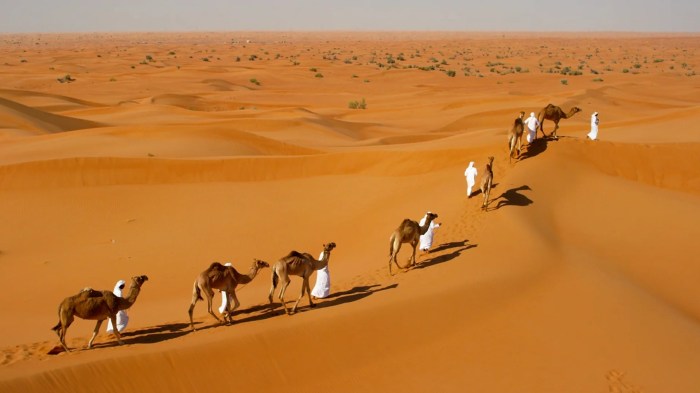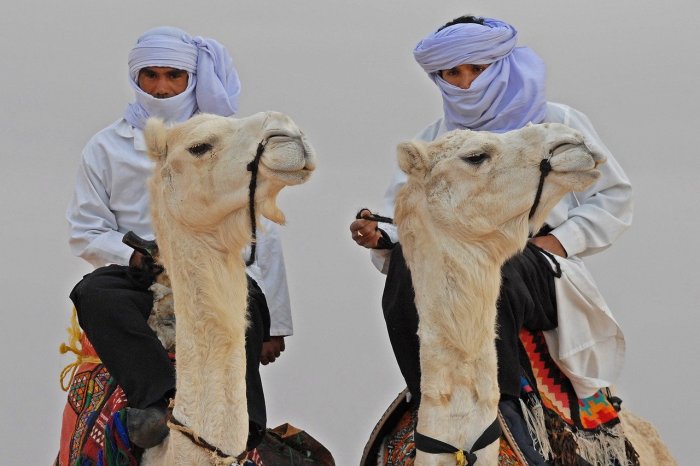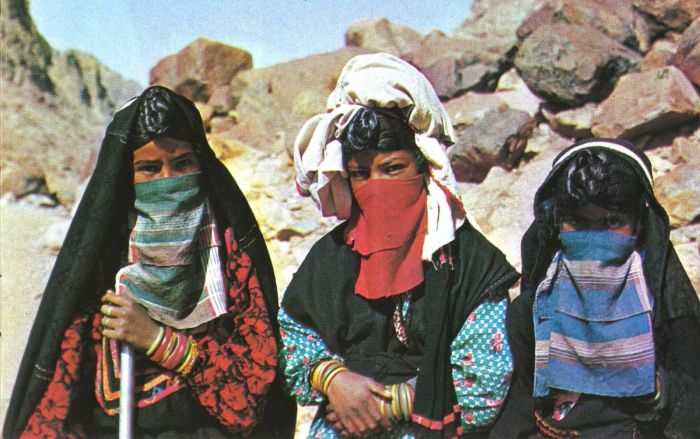Bedouin, the enigmatic nomads of the desert, have captivated imaginations for centuries. Their unique way of life, steeped in tradition and resilience, forms the backdrop for this captivating narrative that delves into the heart of their culture and heritage.
From their origins as wandering tribes to their intricate social structure and vibrant arts, the Bedouin have left an indelible mark on history. Their story is one of adaptation, survival, and the preservation of a rich cultural legacy.
Bedouin History

Bedouin culture emerged from the harsh deserts of the Arabian Peninsula, where nomadic tribes roamed in search of water and grazing lands. Their way of life, shaped by the unforgiving environment, evolved into a unique set of traditions and customs.
Nomadic Lifestyle
The nomadic lifestyle of the Bedouin was central to their identity. They lived in tents, which could be easily disassembled and transported as they followed the seasonal movements of their herds. This constant movement fostered a deep connection to the land and a strong sense of community among the tribes.
Bedouin Culture

Bedouin culture is a rich tapestry of traditions, customs, and beliefs that have been passed down through generations. Central to their way of life is a deep respect for hospitality, honor, and family.
Hospitality
Hospitality is paramount in Bedouin culture. Guests are welcomed with open arms and treated with the utmost respect. They are offered food, shelter, and protection, regardless of their background or affiliation.
Honor
Honor is a highly valued virtue among Bedouins. It is associated with personal integrity, loyalty, and courage. Dishonorable actions are met with severe consequences, including social ostracism.
Family
Family is the cornerstone of Bedouin society. Extended families live together in close-knit communities, supporting and protecting one another. The eldest male is typically the head of the household and makes important decisions on behalf of the family.
Bedouins, nomadic Arab tribes, have a rich history that spans across vast regions. In Anatolia , they played a significant role in shaping the cultural landscape. The Bedouin’s traditional way of life, centered around herding and trade, left an enduring mark on the region’s traditions and customs.
Today, the legacy of the Bedouin continues to influence the vibrant cultural tapestry of Anatolia.
Bedouin Lifestyle

Bedouin tribes have led a nomadic lifestyle for centuries, traversing the vast and unforgiving deserts of the Middle East. Their way of life has been shaped by the unique challenges and opportunities presented by this arid environment.
The Bedouin’s nomadic existence has necessitated a highly adaptable lifestyle. They move their encampments regularly to find new sources of water and grazing land for their animals. Their tents are made of goat hair or sheep wool, providing shelter from the harsh desert sun and wind.
Subsistence
The Bedouin’s primary source of sustenance is livestock, primarily camels, goats, and sheep. These animals provide them with milk, meat, and transportation. They also engage in limited agriculture, cultivating small plots of land near oases or water sources.
Challenges and Adaptations
- Water Scarcity: The desert environment poses significant challenges to water availability. Bedouin tribes have developed intricate water conservation techniques, such as digging deep wells and utilizing rainwater harvesting systems.
- Extreme Temperatures: The desert experiences extreme temperature fluctuations. Bedouin tents are designed to provide shelter from the scorching sun and cold nights.
- Sandstorms: Sandstorms are a common occurrence in the desert. Bedouin tribes protect themselves by covering their faces and seeking shelter in their tents.
Bedouin Economy

Traditionally, Bedouin tribes have relied on herding, trading, and agriculture as their primary economic activities. Herding has been the mainstay of their livelihood, with sheep, goats, and camels being the most common livestock. The Bedouin have developed intricate knowledge of animal husbandry and grazing patterns, allowing them to navigate the harsh desert environment.
Bedouin communities have inhabited the arid landscapes of the Middle East for centuries, leading a nomadic lifestyle in search of water and grazing land. Their cultural heritage and traditions have been preserved through generations, from intricate weaving and jewelry-making to a deep connection to the desert environment.
In recent years, the city of Albany , New York, has become home to a growing community of Bedouins who have brought their unique customs and perspectives to the region, enriching the cultural tapestry of this historic city.
Trading has also played a significant role in Bedouin economy. They have acted as intermediaries between settled communities and nomadic tribes, exchanging goods such as livestock, dates, and salt. Additionally, they have engaged in long-distance trade routes, connecting the Arabian Peninsula with other regions of the Middle East and beyond.
Agriculture
Agriculture has been practiced by some Bedouin tribes, particularly those who have settled in oases or near water sources. They have cultivated crops such as dates, wheat, and barley, using traditional irrigation techniques to overcome the arid conditions.
Impact of Modernization and Globalization
In recent decades, the Bedouin economy has undergone significant changes due to modernization and globalization. The introduction of modern transportation and communication technologies has facilitated access to markets and resources, leading to increased commercialization of Bedouin products.
However, these changes have also brought challenges. The encroachment of modern infrastructure and the expansion of urban areas have reduced grazing land and traditional trade routes, impacting the livelihoods of Bedouin communities. Additionally, the influx of imported goods has led to competition for local products, affecting the economic viability of traditional Bedouin crafts and agriculture.
Bedouin Art and Crafts

Bedouin art and crafts are deeply rooted in their nomadic lifestyle and rich cultural heritage. These crafts have played a significant role in preserving and expressing Bedouin identity and traditions.
Weaving
Weaving is a vital part of Bedouin culture, and Bedouin women are renowned for their exquisite weaving skills. They use natural materials such as wool, goat hair, and camel hair to create a variety of textiles, including rugs, blankets, and clothing. The intricate patterns and vibrant colors of Bedouin weavings reflect their nomadic lifestyle and the surrounding environment.
Embroidery
Embroidery is another important art form in Bedouin culture. Bedouin women use colorful threads to create elaborate designs on clothing, bags, and other textiles. The motifs often depict traditional symbols, such as camels, desert landscapes, and geometric patterns. Bedouin embroidery is highly valued for its beauty and craftsmanship.
Jewelry Making
Bedouin jewelry is known for its intricate designs and use of precious metals, such as silver and gold. Bedouin women wear a variety of jewelry, including necklaces, bracelets, earrings, and headpieces. The jewelry often features traditional motifs and is adorned with gemstones, beads, and coins.
Bedouin Social Structure

The Bedouin society is organized into a hierarchical structure based on lineage and kinship. The tribe is the primary social unit, led by a sheikh who is responsible for making decisions and resolving disputes.
Hierarchy, Bedouin
| Rank | Responsibilities |
|---|---|
| Sheikh | Leader of the tribe, responsible for decision-making and dispute resolution |
| Elders | Advisors to the sheikh, provide guidance and wisdom |
| Warriors | Protect the tribe from external threats |
| Women | Responsible for domestic duties and raising children |
| Children | Future members of the tribe |
Bedouin Language and Literature

The Bedouin language is a dialect of Arabic spoken by the Bedouin people of the Arabian Peninsula. It is a living language with many regional variations, reflecting the nomadic lifestyle of its speakers. The Bedouin language is an important part of Bedouin culture, and it plays a vital role in preserving their history and traditions.
Oral Tradition
Oral tradition is of great importance to the Bedouin people. They have a rich tradition of storytelling, poetry, and song, which has been passed down from generation to generation. This oral tradition has helped to preserve Bedouin history and culture, and it continues to play a vital role in their society today.
Bedouin Architecture

The Bedouins have developed unique architectural styles and designs for their dwellings, adapted to suit the harsh desert environment. Their traditional structures are designed to provide shelter from the sun, sand, and wind, while also being easily transportable as they move with their herds.
Tents
The most iconic Bedouin dwelling is the tent, known as a “beit al-sha’ar” or “black tent.” These tents are made from goat hair or sheep wool, which provides insulation and protection from the elements. The tents are typically large and spacious, with a central pole supporting a framework of wooden beams. The sides of the tent are covered with woven mats or animal skins, and the floor is covered with rugs or carpets.
Houses
In some areas, Bedouins have also built permanent or semi-permanent houses made of stone, mud, or wood. These houses are typically small and simple, with a single room or a few rooms arranged around a central courtyard. The walls are often thick to provide insulation, and the roofs are flat to collect rainwater.
Adaptations
The Bedouin have made several adaptations to their architecture to suit the desert environment. For example, the tents are often oriented to face away from the prevailing wind, and the entrances are typically covered with a flap to keep out sand and dust. The houses are often built on elevated ground to avoid flooding, and they have small windows to minimize heat gain.
Bedouin Religion and Spirituality
Bedouin tribes adhere to a blend of traditional beliefs and Islam, which plays a pivotal role in shaping their culture and society.
Islam has deeply influenced Bedouin society, providing a framework for their daily lives, social interactions, and religious practices. Bedouins observe the five pillars of Islam, including prayer, fasting, and pilgrimage to Mecca. They also follow Islamic dietary laws and ethical principles, which guide their behavior and decision-making.
Animistic Beliefs
Despite their adherence to Islam, many Bedouin tribes still hold animistic beliefs, attributing spiritual significance to natural elements such as trees, rocks, and animals. They believe that these elements possess spirits or powers that can influence their lives and well-being.
Spirituality in Daily Life
Spirituality is deeply ingrained in Bedouin daily life. They often invoke blessings and prayers before important events, such as journeys or hunts. They also seek guidance and protection from spiritual entities, such as saints or spirits of ancestors.
Influence of Sufism
Sufism, a mystical branch of Islam, has had a significant influence on Bedouin spirituality. Bedouin tribes often have their own Sufi orders, which provide a path for spiritual development and connection with the divine. Sufi practices, such as chanting, meditation, and pilgrimage, are incorporated into Bedouin religious rituals.
Shrines and Pilgrimage
Bedouins often venerate local shrines dedicated to saints or holy figures. These shrines are places of pilgrimage where people seek blessings, make offerings, and pray for intercession. Pilgrimage to these shrines is considered a sacred duty and an opportunity for spiritual renewal.
Modern Challenges Facing Bedouins

Bedouin communities, with their unique culture and traditions, face challenges in the modern world. Urbanization, climate change, and cultural assimilation pose significant threats to their way of life.
Urbanization
The rapid urbanization of the Middle East and North Africa has led to a decline in the number of Bedouins living a nomadic lifestyle. As cities expand, traditional grazing lands are lost, forcing Bedouins to settle in urban areas. This transition can be challenging, as Bedouins often struggle to adapt to the fast-paced, modern lifestyle.
The Bedouin, with their rich nomadic culture and deep connection to the desert, have a unique perspective on history. Their traditions and stories have been passed down through generations, offering valuable insights into the past. One such event that has left a profound impact on the Bedouin community is the auschwitz tour.
The horrors witnessed in the concentration camps have shaped their understanding of human suffering and resilience, leaving an indelible mark on their collective memory.
Climate Change
Climate change is also having a significant impact on Bedouin communities. Droughts and desertification are becoming more common, making it difficult for Bedouins to maintain their traditional herding practices. Water scarcity is another major challenge, as Bedouins rely on traditional wells and springs that are increasingly drying up.
Cultural Assimilation
As Bedouins settle in urban areas, they are increasingly exposed to Western culture and values. This can lead to the loss of traditional Bedouin customs and practices. In some cases, Bedouins may feel pressure to conform to the dominant culture, which can result in the erosion of their unique identity.
Preservation Efforts
Despite these challenges, there are efforts being made to preserve Bedouin culture and traditions. Governments and NGOs are working to protect traditional grazing lands and provide support to Bedouins who are transitioning to urban life. Educational programs are also being developed to teach young Bedouins about their history and culture.
Final Review
As the sands of time shift and the modern world encroaches upon their traditional way of life, the Bedouin face new challenges. Yet, their spirit of resilience and their unwavering commitment to their heritage ensure that their culture will continue to thrive for generations to come.
Through their captivating traditions, indomitable spirit, and deep connection to the desert, the Bedouin continue to inspire and fascinate, reminding us of the enduring power of human resilience and the beauty of cultural diversity.
Question & Answer Hub: Bedouin
Who are the Bedouin?
The Bedouin are nomadic Arab tribes who have traditionally inhabited the deserts of the Middle East and North Africa.
What is the Bedouin lifestyle like?
The Bedouin live a nomadic lifestyle, moving from place to place in search of water and grazing land for their animals.
What is the Bedouin culture like?
The Bedouin culture is rich in tradition and hospitality. They are known for their strong sense of community and their respect for elders.
What are the challenges facing the Bedouin today?
The Bedouin face a number of challenges today, including urbanization, climate change, and cultural assimilation.